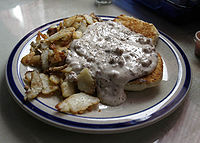- Gravy
-
Gravy is a sauce made often from the juices that run naturally from meat or vegetables during cooking. In North America the term can refer to a wider variety of sauces and gravy is often thicker than in Britain. The gravy may be further coloured and flavoured with gravy salt[1] (a simple mix of salt and caramel food colouring) or gravy browning (gravy salt dissolved in water) or ready-made cubes and powders can be used as a substitute for natural meat or vegetable extracts. Canned gravies are also available. Gravy is commonly served with roasts, meatloaf, rice,[2] and mashed potatoes.
Contents
Historical origins
Gravy is thought to have originated in Egypt around 3000 BC. Hieroglyphs in the tomb of Djer, an early first dynasty pharaoh, at Umm el-Qa'ab are said to resemble Classical Greek clay vessels, from which the modern French sauce boat (or gravy boat) was ultimately developed. Paintings on the walls of the tomb depicting feasting show the diners (presumably members of the royal court) drinking a liquid, however the context does not lend itself to wine, beer or blood.[3]
Thickened gravy
Gravies are often thickened with a starch, starting with a roux made of wheat flour, cornstarch/cornflour, or arrowroot. Spare Yorkshire pudding batter may be used also. The liquids from cooked meat, the liquids from dissolved bouillon cubes/stock cubes, or stock are added gradually to the mixture, while continually stirring to ensure it mixes properly and the thickener does not clump. In some recipes, the animal fat in the roux may be omitted as part of the base content. It may be replaced with cornstarch/cornflour alone.
Types of gravy
- Chocolate gravy is a variety of gravy made with fat, flour, cocoa powder and sometimes a small amount of sugar.
- Cream gravy is made with one to one and a half cups of milk added to the roux. It is seasoned with salt and pepper. It is common to the American South and is frequently served with chicken fried steak.
- Egg gravy is a breakfast gravy that is served over biscuits. Meat drippings (usually from bacon) and flour are used to make a thick roux. The roux is salted and peppered to taste, Water and milk (even parts) are added, and the liquid is brought back up to a boil. A well-beaten egg is then slowly added while the gravy is stirred or whisked swiftly, cooking the egg immediately and separating it into small fragments in the gravy.
- Giblet gravy has the giblets of turkey or chicken added when it is to be served with those types of poultry, or uses stock made from the giblets.
- Onion gravy is made from large quantities of slowly sweated, chopped onions mixed with stock and wine. Commonly served with bangers and mash, eggs, chops, or other grilled or fried meat which by way of the cooking method would not produce their own gravy.
- Red-eye gravy is a gravy made from the drippings of ham fried in a skillet/frying pan. The pan is deglazed with coffee. This gravy is a staple of Southern U.S. cuisine and is usually served over ham, grits or biscuits.[citation needed]
- Spiced gravy This is a gravy that originated in ancient India. Used in mild curries, it was a popular ingredient in bringing out flavor in meats. On its own, however, it has an acquired taste as its musty fragrance puts people off. Recipes for using it can be found in most cookbooks. The main ingredients in spiced gravy are cloves, rosemary, mustard seeds, and coconut milk. Animal fat can be added to thicken the gravy.
- Tomato gravy is not gravy at all, but a kind of tomato sauce, made from canned or fresh tomatoes, flour, and usually a small amount of fat. This is generally considered a Southern U.S. dish.[4]
- Vegetable gravy or vegetarian gravy is gravy made with boiled or roasted vegetables. A quick and flavorful vegetable gravy can be made from any combination of vegetable broth or vegetable stock, flour, and one of either butter, oil, or margarine. One recipe uses vegetarian bouillon cubes with cornstarch (corn flour) as a thickener (cowboy roux), which is whisked into boiling water. Sometimes vegetable juices are added to enrich the flavor, which may give the gravy a dark green color. Wine could be added. Brown vegetarian gravy can also be made with savory yeast extract like Marmite or Vegemite. There are also commercially produced instant gravy granules which are suitable for both vegetarians and vegans.
- White gravy (sawmill gravy in Southern U.S. cuisine) is the gravy typically used in biscuits and gravy and chicken fried steak. It is essentially a Béchamel sauce, with the roux being made of meat drippings and flour. Milk or cream is added and thickened by the roux; once prepared, black pepper and bits of mild sausage or chicken liver are sometimes added. Besides white and sawmill gravy, common names include country gravy, milk gravy, and sausage gravy.
Cuisines
Gravy is commonly eaten with pork, chicken, lamb, turkey, beef, meatloaf, American style biscuits, Yorkshire pudding,[5] stuffing and sandwiches. One Southern American variation is sausage gravy eaten with American biscuits. In the UK, a Sunday roast is usually served with gravy. It is also popular in different parts of the UK, to have gravy with just chips (mostly from a fish'n'chip shop), a dish common with Australia and Canada. Gravy is an integral part of the Canadian dish poutine. A Southern U.S. dish that has white gravy is chicken fried steak.
In many parts of Asia, particularly India, Malaysia, and Singapore, the word "gravy" is used to refer to any thickened liquid part of a dish. For example, the liquid part of a thick curry may be referred to as gravy.[6][7][8]
In British cuisine, as well as in the cuisines of Commonwealth countries like Australia and New Zealand, the word gravy only refers to the meat based sauce (and vegetarian/vegan alternatives) derived from meat juices, stock cubes or gravy granules. Use of the word "gravy" does not include other thickened sauces. One of the most popular forms is onion gravy, which is eaten with sausages, fried eggs, Yorkshire pudding and roast meat.
In the Mediterranean, Maghreb cuisine is dominated with gravy and bread-based dishes. Tajine and most Maghreb (Morocco, Algeria and Tunisia) dishes are derivatives of oil, meat and vegetable gravies. The dish is usually served with a loaf of bread. The bread is then dipped into the gravy and then used to gather or scoop the meat and vegetables between the index, middle finger and thumb, and consumed.
In gastronomy of Minorca, it is used since the British colonisation during the 17th century in typical Minorquian and Catalan dishes, as for example macarrons amb grevi (pasta).[9]
In the case of meat served with potatoes, vegetables, and gravy, in North America (except Quebec), the gravy is often poured onto the potatoes, whereas in Quebec or France the gravy is generally poured onto the meat.[citation needed]
Health concerns
Gravy made from well-done beef has been shown to contain heterocyclic amines, which are potentially carcinogenic in humans.[10][11]
Cultural use
Gravy, and its perceived richness, have contributed to its use in several cultural contexts:
- Used as a descriptive noun[who?], and synonymous to the word copasetic, gravy indicates that all is well. "Don't worry, we're gravy."
- The idiom "gravy train", used to refer to any lucrative endeavor.
- Also used as slang for extra benefits in the idiom "everything else is gravy."
See also
- Sauce boat, also referred to as a Gravy Boat
- Cuisine of the Southern United States
- Curry
References
- ^ Old Jake's gravy salt
- ^ Real Cajun Recipes : : Rice and Gravy
- ^ Shaw, Ian. The Oxford History of Ancient Egypt. p. 69. Oxford University Press. 2000. ISBN 0-19-280458-8
- ^ "Mountain Gravies". Smokehouse Ham, Spoon Bread, & Scuppernong Wine; The Folklore and Art of Southern Appalachian Cooking. Nashville Tennessee: Cumberland House. 1989. ISBN 1-88952-93-8.
- ^ British Yorkshire Pudding Day
- ^ Basic Indian gravy
- ^ List of Indian gravy dishes
- ^ Indian curry and gravy dishes
- ^ Xim Fuster i Manel Gómez: Menorca: gastronomía y cocina. Sant Lluís. 2005. Ed. Triangle Postals. ISBN 84-8478-187-9
- ^ Sinha R, et al. (1998). "Heterocyclic amine content in beef cooked by different methods to varying degrees of doneness and gravy made from meat drippings.". Food Chem Toxicol. 36 (4): 279–87. doi:10.1016/S0278-6915(97)00162-2. PMID 9651044.
- ^ Ni W, et al. (2008). "Quantitation of 13 heterocyclic aromatic amines in cooked beef, pork, and chicken by liquid chromatography-electrospray ionization/tandem mass spectrometry". J Agric Food Chem. 56 (1): 68–78. doi:10.1021/jf072461a. PMID 18069786.
Categories:- Sauces
- Non-Newtonian fluids
Wikimedia Foundation. 2010.



